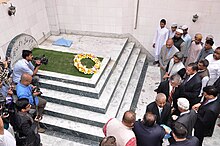
Quick Facts

Biography
Begum Hazrat Mahal (Urdu: بیگم حضرت محل; c. 1820 – 7 April 1879), also known as Begum of Awadh, (OUDH) was the first wife of Nawab Wajid Ali Shah. She rebelled against the British East India Company during the Indian Rebellion of 1857. After her husband had been exiled to Calcutta, she took charge of the affairs in the state of Awadh and seized control of Lucknow. She also arranged for her son, Prince Birjis Qadra, to become Wali (ruler) of Awadh; However, he was forced to abandon this role after a short reign. She finally found asylum in Nepal where she died in 1879.
Biography
Mahal's maiden name was Muhammadi Khanum, and she was born at Faizabad, Awadh, India. She was a courtesan by profession and had been taken into the royal harem as a khawasin after being sold by her parents. She was then sold to Royal agents, and later promoted to a pari, and was known as Template:Mahak Pari. She became a begum after being accepted as a royal concubine of the King of Oudh, and the title 'Hazrat Mahal' was bestowed on her after the birth of their son, Birjis Qadra.
She was a junior wife of the last Tajdaar-e-Awadh, Wajid Ali Shah. The British had annexed Oudh in 1856 and Wajid Ali Shah was exiled to Calcutta. After her husband was exiled to Calcutta, she took charge of the affairs of the state of Awadh despite her divorce from the Nawab, which then was a large part of the current state of Uttar Pradesh, India.
Indian Rebellion of 1857
During the First War of Independence, from 1857 to 1858, Begum Hazrat Mahal's band of supporters, led by Raja Jailal Singh, rebelled against the forces of the British East India Company; later, they seized control of Lucknow and she declared her son, Birjis Qadra, as the ruler (Wali) of Oudh. When the forces under the command of the British re-captured Lucknow and most of Oudh, she was forced to retreat. Hazrat Mahal worked in association with Nana Saheb, but later joined the Maulavi of Faizabad in the attack on Shahjahanpur.
One of the principal complaints of Begum Hazrat Mahal was that the East India Company had casually demolished temples and mosques to make way for roads. In a proclamation issued during the final days of the revolt, she mocked the British claim to allow freedom of worship:
To eat pigs and drink wine, to bite greased cartridges and to mix pig's fat with sweetmeats, to destroy Hindu and Mussalman temples on pretense of making roads, to build churches, to send clergymen into the streets to preach the Christian religion, to institute English schools, and pay people a monthly stipend for learning the English sciences, while the places of worship of Hindus and Mussalmans are to this day entirely neglected; with all this, how can people believe that religion will not be interfered with?
Later life
Ultimately, she had to retreat to Nepal, where she was initially refused asylum by the Rana prime minister Jang Bahadur, but was later allowed to stay. She died there in 1879 and was buried in a nameless grave in the grounds of Kathmandu's Jama Masjid.
Memorials

Begum Hazrat Mahal's tomb is located in central part of Kathmandu near Jame Masjid, Ghantaghar, nor far away from the famous Darbar Marg. It is looked after by the Jama Masjid Central Committee.

On 15 August 1962, Mahal was honoured at the Old Victoria Park in Hazratganj, Lucknow for her role in the The great revolt. Along with the renaming of the park, a marble memorial was constructed, which includes a marble tablet with four round brass plaques bearing the Coat of Arms of the Awadh royal family. The park has been used for Ramlilas and bonfires during Dusshera, as well as Lucknow Mahotsava (Lucknow Exposition).
On 10 May 1984, the Government of India issued a commemorative stamp in honour of Mahal. The first day cover was designed by C.R. Pakrashi, and the cancellation was done by Alka Sharma. 15,00,000 stamps were issued.
